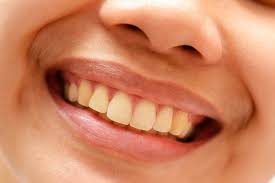In our society, having bright white teeth is associated with beauty, confidence and good health. However, the desire for perfectly white teeth contrasts with the fact that teeth are naturally slightly yellow. Teeth appear white in contrast to darker oral structures because of the principle of visual contrast. The pinkish hue of gums or the darker shades inside the mouth amplify the perception of whiteness. Darker skin tones create a strong contrast with teeth, making even naturally yellowish teeth look whiter.
There is great misconception about Yellow Teeth. They do not necessarily indicate poor oral health. In fact, the natural coloration is due to structure of the teeth.
Structure of teeth
Human teeth have two layers of visible hard tissues;
Enamel: It is hard and protective outer layer which is translucent. Its translucency allows some light to pass through, revealing the underlying dentin, which significantly influences the tooth color.
Dentin: The inner layer of teeth is known as Dentin which is trans opaque and yellowish in color. This color shows through the enamel.
Societal Perception
In many cultures, white teeth symbolize youth, cleanliness, and success, leading people to strive for teeth that appear unnaturally white. Advertisements and celebrities often portray ultra-white teeth as the standard of beauty, creating unrealistic expectations. Moreover, the availability of whitening products and treatments has further fueled the desire for whiter teeth, even when natural yellowish tones are perfectly healthy.
Factors Influencing Enamel Appearance
Aging: Enamel wears down over time due to chewing, brushing, and acid exposure, making the dentin more visible.
Stains: Although enamel is resistant to stains, its surface can become discolored over time due to dietary habits, smoking, or poor oral hygiene. Removal stains doesn’t require teeth whitening but simple professional cleaning.
Thickness of Enamel: The thickness of enamel affects the degree of its translucency. Thicker enamel appears whiter because it masks more of the dentin color while thinner enamel appears more yellow or gray as the dentin color becomes more prominent.
Enamel thickness also decreases over time when exposed to harsh whitening agents or abrasive materials. Many teeth-whitening products, especially those with high concentrations of hydrogen peroxide or carbamide peroxide, erode enamel if overused. These chemicals penetrate the enamel to remove stains but may weaken the outer layer with repeated application. Toothpastes or powders with excessive abrasives (e.g., charcoal-based or baking soda products) can physically wear down enamel during brushing. This abrasive action removes surface stains but can also thin the protective enamel layer over time.
Balancing Aesthetics and Health
While striving for a confident smile is natural, it’s important to remember that purely white teeth are very rare and usually the result of cosmetic treatments. Healthy teeth, regardless of their shade, are more important than achieving an artificial whiteness. If your teeth are healthy but naturally yellowish, it’s normal and nothing to worry about.





